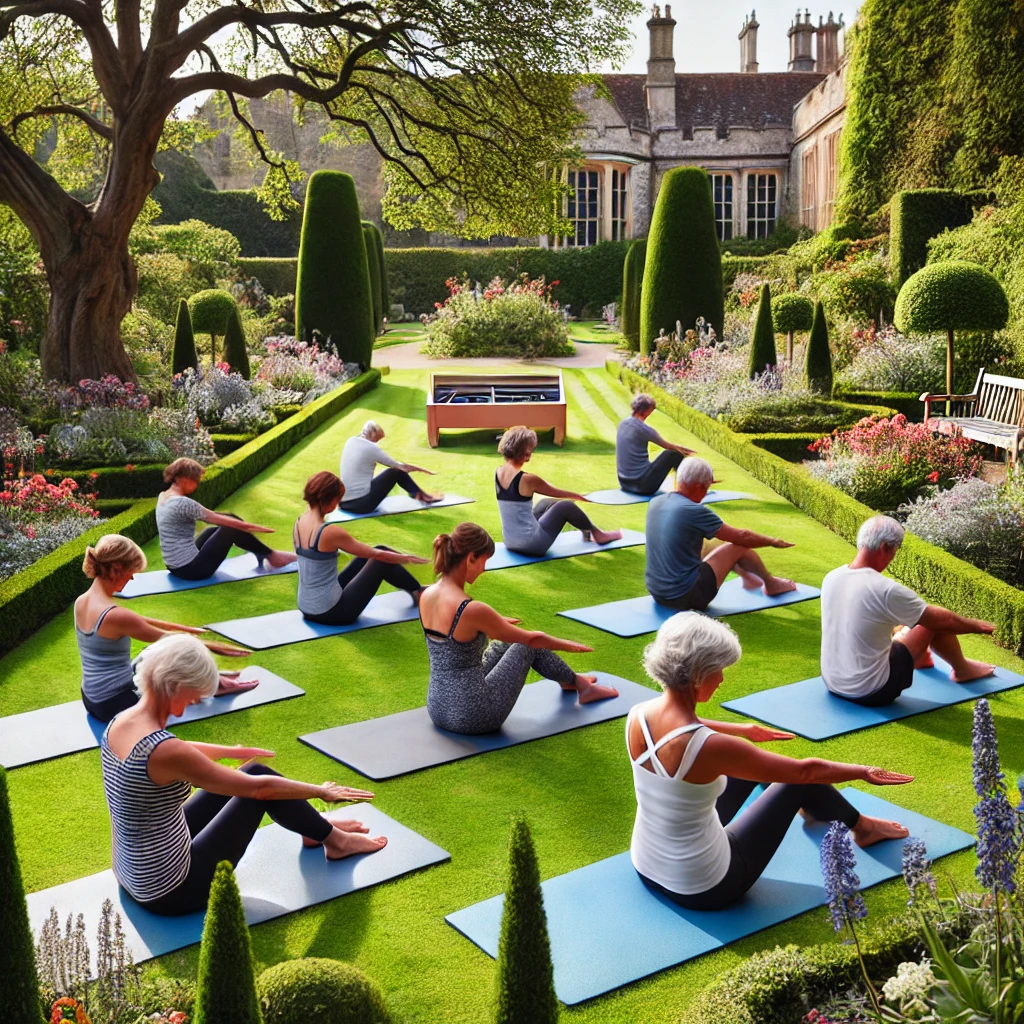Table of Contents

Introduction to Outdoor Exercise
In recent years, outdoor exercise has gained immense popularity across the United Kingdom. As more people seek healthier and more fulfilling lifestyles, the appeal of engaging in physical activities amidst nature’s splendor has grown substantially. This trend encompasses a variety of exercise forms, including running, cycling, yoga, and team sports like football and rugby, turning our parks, gardens, and countryside into lively hubs of health and vitality.
The surge in outdoor activities can be attributed to multiple factors, such as the increasing accessibility of green spaces, growing public awareness about the health benefits of nature exposure, and a broader cultural shift towards sustainability and environmental stewardship. For many, outdoor exercise provides an enjoyable alternative to indoor gyms, breaking the monotony and offering a refreshing change of scenery.
This blog post aims to delve into the multifaceted benefits of engaging in outdoor exercise within the UK’s plentiful green spaces. By exploring various dimensions – physical health, mental well-being, and social connectivity – we hope to highlight the advantages of integrating nature into routine fitness practices. Whether you are an avid runner who enjoys the trails of your local park or someone new to outdoor yoga sessions, this exploration will provide valuable insights into how the natural environment can enhance your exercise experience.
Furthermore, we will look at why the UK’s green spaces, ranging from city parks to national forests, serve as ideal locations for outdoor fitness. These areas are not only easily accessible but also offer diverse terrains and landscapes that cater to different exercise preferences and intensities. By making the most of these natural resources, individuals can achieve a balanced and holistic approach to health, which is both invigorating and sustainable.
Physical Health Benefits
Engaging in outdoor exercise in the UK’s green spaces offers a plethora of direct physical health benefits that significantly enhance one’s overall well-being. One of the most notable advantages is the improvement in cardiovascular health. Activities like jogging, cycling, or even brisk walking in nature help elevate heart rate and promote better blood circulation, thereby reducing the risk of heart disease. Additionally, these activities improve lung capacity, making the respiratory system more efficient.
Strength and flexibility are also markedly improved through varied outdoor exercises. Unlike the repetitive motions often experienced in gym settings, natural terrains provide uneven surfaces that engage different muscle groups, enhancing muscle tone and joint flexibility. For instance, hiking on trails can build lower body and core strength, while stretching in a park setting significantly improves overall flexibility.
Endurance is another critical benefit gained from regular outdoor exercise. Long-distance running or cycling not only augments cardiovascular stamina but also trains the body to use oxygen more efficiently, improving overall physical endurance. This type of exercise is especially beneficial in natural environments where the air quality is often superior to urban areas.
Moreover, exercising in natural settings supports effective weight management. Activities such as running, hiking, and cycling burn calories at a higher rate compared to indoor workouts due to the additional challenge posed by natural elements. This enhances metabolism, aiding in weight maintenance and reducing the risk of obesity.
Lastly, the likelihood of developing chronic illnesses such as hypertension and diabetes decreases with consistent outdoor physical activity. Regular exposure to natural light helps regulate sleep patterns and synthesizes Vitamin D, crucial for bone health and immune system efficiency. Furthermore, the physical exertion involved in outdoor activities helps regulate blood pressure and blood sugar levels, lowering the risk factors associated with these chronic diseases.

Mental Health Benefits
Engaging in outdoor exercise within the UK’s green spaces has been consistently associated with significant mental health benefits. One of the profound effects is the reduction in stress levels. Being surrounded by nature while engaging in physical activity can significantly lower cortisol levels, the hormone associated with stress. The tranquil and verdant surroundings found in parks, forests, and other natural settings provide a calming environment, allowing individuals to decompress and unwind.
Moreover, outdoor exercise plays a crucial role in alleviating symptoms of depression and anxiety. Several studies have demonstrated that regular physical activity in green spaces can lead to a decrease in depressive symptoms. The combination of exercise-induced endorphin release and exposure to natural light boosts serotonin levels, which is vital for mood regulation. This dual mechanism offers a natural and effective way to manage depression and anxiety, potentially reducing reliance on medication.
Another significant mental health benefit is the improvement of overall mood. The inherent beauty and serenity of the UK’s green spaces can elevate one’s spirits. Activities such as walking, running, or cycling in these areas stimulate the release of neurotransmitters like dopamine, which are known to enhance feelings of pleasure and satisfaction. This mood enhancement can be more pronounced compared to indoor exercise, where the environment might not provide the same level of sensory engagement.
Furthermore, participating in outdoor exercise can lead to an overall boost in mental well-being. It promotes a sense of connection with nature, which has been shown to enhance mindfulness and reduce feelings of isolation. The social opportunities provided by group activities in green spaces also contribute to a sense of community and belonging, which are essential components of mental health.
In summary, the act of exercising in the UK’s green spaces provides a comprehensive boost to mental health by reducing stress, alleviating symptoms of mental health disorders, improving mood, and fostering overall well-being.
Social Benefits and Community Building
Engaging in outdoor exercise in the UK’s green spaces offers more than just physical benefits; it also provides valuable social advantages. These natural environments serve as ideal venues for individuals to join fitness groups, sports teams, or participate in community events. By attending these outdoor activities, individuals are presented with opportunities to expand their social networks and foster a sense of belonging that is often difficult to achieve through indoor or solitary exercises.
One of the key social benefits of outdoor exercise is the ability to connect with like-minded individuals. Whether it’s a local park’s running club, a weekly yoga session on the communal green, or even a casual meet-up for cycling excursions, these group activities create platforms where people can share common interests and experiences. This social interaction is particularly beneficial for those who struggle with loneliness, as it provides a structured and supportive environment for making new friends and acquaintances.
Furthermore, participating in community-led fitness initiatives can significantly improve one’s sense of community. Events such as charity walks, local sports tournaments, and city-wide fitness challenges not only encourage physical well-being but also instill a sense of pride and camaraderie among participants. These activities often involve collaborative efforts that require teamwork and cooperation, thus strengthening communal bonds and social ties.
For individuals seeking to expand their social networks, outdoor exercise is a natural conduit for developing these connections. Regular attendance in group exercises and community events allows for repeated interactions, leading to deeper relationships over time. Additionally, the inclusive and welcoming nature of outdoor fitness activities ensures that newcomers feel comfortable and supported, making it easier to integrate into new social circles.
In essence, outdoor exercise in the UK’s green spaces offers invaluable social benefits, fostering community building and providing social support systems that enhance both mental and physical well-being. For many, this blending of health and social interaction is an essential aspect of a balanced lifestyle, contributing to a more connected and supportive society.
Connection with Nature and Environmental Awareness
Engaging in outdoor exercise within the UK’s abundant green spaces offers a unique opportunity to foster a stronger connection with nature. As individuals immerse themselves in natural surroundings, they often develop a deeper appreciation for the environment. This enhanced appreciation can manifest in various forms, from a profound sense of tranquillity to a more acute awareness of the ecological value of these spaces. Engaging in activities such as hiking, jogging, or cycling not only promotes physical well-being but also serves to heighten one’s sensory engagement with the natural world.
The mental clarity achieved through exercising in green spaces is another significant benefit. Studies have indicated that spending time in nature can reduce stress, improve cognitive function, and enhance overall mental health. The sights, sounds, and smells of the natural environment can offer a refreshing escape from the urban hustle and bustle, allowing individuals to reset and rejuvenate. This mental respite is vital for maintaining focus and productivity in daily life.
Moreover, regular exercise in natural settings often leads to a greater sense of environmental stewardship. As people spend more time in green spaces, they tend to become more mindful of their surroundings and the impact of their actions on these areas. This awareness can inspire individuals to adopt more sustainable lifestyles, whether through reduced waste, conservation efforts, or advocating for the preservation of green spaces. The sense of responsibility towards the environment cultivated through this connection is crucial for fostering long-term ecological sustainability.
Therefore, the integration of outdoor exercise within the UK’s green spaces not only benefits physical and mental health but also plays a crucial role in enhancing environmental awareness. By encouraging a closer relationship with nature, individuals can contribute positively to their well-being and support the broader goals of environmental preservation and sustainability.
Accessibility and Variety of Green Spaces in the UK
The United Kingdom boasts an impressive array of green spaces, ranging from sprawling national parks to intimate urban gardens. This diversity ensures that individuals seeking the benefits of outdoor exercise have a plethora of options tailored to their fitness levels and interests. Urban green spaces, such as Hyde Park in London or Heaton Park in Manchester, are easily accessible by public transport and provide a convenient escape from city life. These spaces often feature well-maintained paths, open fields, and sports facilities, accommodating a wide array of physical activities, from running and cycling to yoga and tai chi.
For those looking for more challenging terrains, the UK’s national parks offer rugged landscapes and breathtaking scenery. Areas such as the Lake District or Snowdonia National Park present opportunities for hiking, mountain biking, and rock climbing. These destinations, while requiring more significant travel, reward visitors with unique natural beauty and the chance to experience outdoor exercise in a more immersive and invigorating environment.
In addition to these high-profile locations, rural landscapes and smaller local parks provide equally valuable opportunities for exercise and relaxation. These areas are often nestled within communities and serve as vital green lungs that enhance the quality of life for residents. Trails through woodlands, open countryside, and along riverbanks cater to walkers and runners of all proficiency levels. Their accessibility promotes regular exercise, allowing individuals to integrate physical activity seamlessly into their everyday routines.
The preservation and maintenance of these green spaces are crucial. They are public treasures that support physical health, mental well-being, and social interaction. Local councils, national organizations, and volunteer groups play pivotal roles in ensuring these areas remain safe, attractive, and available for public use. By protecting these spaces, the UK continues to foster an environment where outdoor exercise can flourish, offering a wealth of benefits to its citizens.
Tips for Safe and Enjoyable Outdoor Exercise
Engaging in outdoor exercise is an excellent way to harness the numerous benefits of the UK’s green spaces. However, to ensure that your workouts are both safe and enjoyable, several practical considerations should be kept in mind. One crucial aspect is selecting the appropriate attire and footwear. Wearing moisture-wicking clothing and comfortable, supportive shoes can enhance your performance and prevent injuries. Layering is also advisable, especially in the UK’s variable weather, as it allows you to adjust your clothing based on temperature changes.
Hydration is another vital factor when exercising outdoors. Always carry a water bottle with you, especially during warmer months or intense physical activities. Dehydration can impede performance and pose serious health risks. Ensuring proper hydration before, during, and after workouts can significantly improve your exercise experience.
Safety measures are paramount when venturing into green spaces for exercise. Familiarize yourself with the area beforehand, and try to stick to well-trodden paths if you’re uncertain about the terrain. Inform someone of your plans or exercise with a companion, particularly in secluded or unfamiliar areas. Wearing reflective gear and carrying a whistle or personal alarm can also enhance your safety, especially during early morning or late evening workouts.
The type of exercises you perform should be tailored to the location. Urban parks often have designated areas for different activities, such as jogging trails, cycling paths, and open fields for calisthenics or yoga. Nature reserves and countryside locations may offer opportunities for hiking, trail running, or even open-water swimming. Adaptability is key when exercising outdoors; seasonal and weather changes can impact your routine. In colder months, shorter, more intense workouts can be beneficial, while warmer months might allow for longer, more leisurely sessions. Always check the weather forecast and prepare accordingly to ensure a safe and productive outdoor exercise experience.
Conclusion and Encouragement to Explore
In summary, the myriad benefits of outdoor exercise in the UK’s green spaces cannot be overstated. Engaging in physical activities amidst nature offers unparalleled advantages that encompass both physical and mental health. From improving cardiovascular fitness and strengthening muscles to boosting mood and alleviating symptoms of depression and anxiety, the positive impacts of spending time in nature are well-documented by science and endorsed by countless studies.
The accessibility of green spaces across the UK provides a wonderful opportunity for people of all ages and fitness levels to partake in outdoor exercise. Whether it’s brisk walking in local parks, cycling through scenic trails, or practicing yoga on a tranquil field, these activities are not only enjoyable but also foster a deeper connection with nature. Furthermore, engaging in outdoor exercise can enhance social interaction, promoting a sense of community and shared well-being.
As you contemplate your fitness regime, consider the rich landscapes surrounding you. The UK boasts a diverse array of parks, forests, and natural reserves, each offering unique environments that invite exploration and physical activity. Making the most of these green spaces can transform routine exercise from a mundane task into an invigorating experience that revitalizes both body and mind.
We encourage you to step outside and embrace these natural environments. Take the time to discover new trails, join local outdoor fitness groups, or simply enjoy a solitary moment surrounded by the beauty of nature. By integrating outdoor exercise into your lifestyle, you not only improve your personal health but also contribute to the preservation and appreciation of these precious green spaces.






